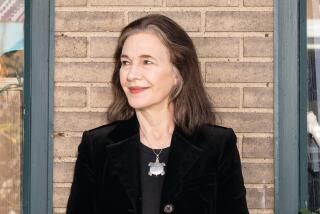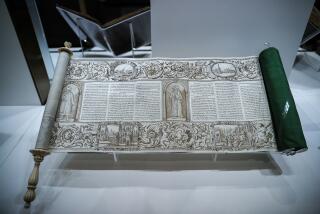A shot resounds
It has been difficult to come back from this novel to the familiar atmosphere of my daily life. I have been through this before with Louise Erdrich, who weaves exotic and erotic spells with her writing. She gets better and better. If her first book, “Love Medicine,” was a concerto, then ever since “The Last Report on the Miracles at Little No Horse,” she has been composing symphonies filled with a complex wisdom about the strands of darkness and light that make up a human life.
“The Plague of Doves” is a multi-generational novel-in-stories of the intertwined lives of the whites in the town of Pluto, N.D., and the Native Americans and mixed-blood Metis people of French ancestry who live on the reservation surrounding it. Moving back and forth in time, four narrators take turns uncovering layer after layer of past and present.
The novel opens with a shotgun blast that will reverberate through all their lives and connect them in breathtaking, sometimes shocking ways. When the first narrator, Evelina, talks with her grandfather, Mooshum, about her fascination with her teacher, Sister Mary Anita Buckendorf, he twists his mouth at the sound of her name. He has always regaled Evelina and her brother with stories of his past adventures, which change with each telling. But the story he tells now is a grim one, and Erdrich does not spare them (or us) from visualizing in detail a horrible crime.
In 1911, two Indian teenagers, Mooshum and Paul Holy Track, along with Paul’s guardian Asiginak, come across the bodies of a murdered farm family and tragically become the prime suspects. The three are strung up on an oak tree, but Mooshum is inexplicably cut down, the only survivor. We won’t find out until much later the significant detail he has omitted from the story.
The next narrator, Judge Antone Bazil Coutts, who will marry Evelina’s aunt, talks about his grandfather Joseph, who joined the town-site expedition that resulted in Pluto. The two Metis guides saved his life. Their younger brother Cuthbert will be one of the lynching victims, and a descendant, Billy Peace, will marry Marn Wolde and found a cult on her father’s farm, the site of that killing tree. Marn narrates the story of her marriage and how, with the aid of the snakes she handles, she escapes from the commune with her children. In synopsis, the plot lines seem operatic, but Erdrich’s artistry and passion had me believing every word. Evelina returns as a university student with dreams of going to France. A bad drug trip, thanks to her dealer cousin Corwin Peace, and the unbearable experience of falling in love with a girl, only to be abandoned, sends her into a total breakdown. We are so deeply inside Evelina that we feel her sick despair, to the point of claustrophobia. The last narrator, Dr. Cordelia Lochren, sends us back to that farm family, whose killer was never identified, until she adds up a few things that happened in her practice and realizes who it was.
Erdrich moves seamlessly from grief to sexual ecstasy, from comedy (Mooshum’s proof of the nonexistence of hell is priceless) to tragedy, from richly layered observations of nature and human nature to magical realism. She is less storyteller than medium. One has the sense that voices and events pour into her and reemerge with crackling intensity, as keening music trembling between sorrow and joy. Here, for example, is Mooshum’s brother Shamengwa playing the violin. Judge Antone is stirred to the marrow: “The sound connected instantly with something deep and joyous. Those powerful moments of true knowledge that we have to paper over with daily life. The music tapped the back of our terrors, too. . . . Shredded imaginings, unadmitted longings, fear and also surprising pleasures. No, we can’t live at that pitch. But every so often something shatters like ice and we are in the river of our existence.”
There are a number of powerful scenes that, poised on the threshold between dream or premonition and reality, remind me of the equally double-natured light- and shadow-play of Akira Kurosawa’s film “Dreams.” In one, Judge Antone sells his family home to Ted Bursap, a developer, in large part to break free from Bursap’s wife, with whom he’s had an all-consuming affair since he was a teenager. When the backhoe tears down a wall, a deadly cloud of bees emerges and attacks Ted. Antone, calmly watching, removes a piece of honeycomb from the claw of the machine and stuffs it into his mouth, tasting the honey while his lover looks on in horror.
This scene, near the end of the book, recalls the plague of doves Mooshum saw in his childhood, when great dark flocks of them descended on the fields and destroyed the crops. The dove, a symbol of life, becomes a pestilence; the bee, symbol of friendly industriousness and domestic virtue, turns into a killer. In Erdrich’s world, life and death hold each other close. Erdrich understands the potency of stories. Mooshum tells of a time when a story about hunger escaped from the teller and terrorized the countryside. After her first kiss, Evelina sadly thinks, “I had expected to feel joy but instead felt a confusion of sorrow, or maybe fear, for it seemed that my life was a hungry story and I its source. . . . I had now begun to deliver myself into the words.” Later in life, at Judge Antone’s wedding, she realizes, “[w]hen we are young, the words are scattered all around us. As they are assembled by experience, so also are we, sentence by sentence. . . . “ *
More to Read
Sign up for our Book Club newsletter
Get the latest news, events and more from the Los Angeles Times Book Club, and help us get L.A. reading and talking.
You may occasionally receive promotional content from the Los Angeles Times.







